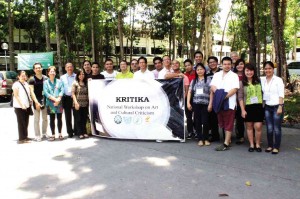
From April 21 to 27, the University of St. La Salle-Bacolod (USLS) was home to Kritika 2013, the national workshop on art and cultural criticism, which was held with the Iyas Creative Writing Workshop.
Organized by the De La Salle University Bienvenido N. Santos Creative Writing Center (DLSU-BNSCWC), and sponsored by the DLSU Office of the Vice Chancellor for Research, National Commission for Culture and the Arts, and USLS, the week-long event provided a significant amount of critical discussion across disciplines.
Spearheaded by Rolando Tolentino, dean of the University of the Philippines-Diliman (UPD) College of Mass Communication and DLSU-BNSCWC associate for criticism, and Shirley Lua, director of the DLSU-BNSCWC, the workshop brought together critics and aspiring critics from different fields and audiences in order to discuss critical practice in the Philippines today.
This year’s Kritika fellows were Ronn Andrew F. Angeles (literature); John Michael de la Paz (visual arts); Glenn H. Diaz (literature); Wennielyn F. Fajilan (literature); Carlo Pacolor Garcia (theater), Skilty Labastilla (film); Rowell Madula (pop culture); Raul C. Navarro (music and history); Cheeno Marlo Sayuno (dance); and Manuel Agustin Singson (architecture).
The discussions were moderated by established critics and practitioners led by Tolentino, who was workshop director: Isagani R. Cruz (pop culture); Isidoro M. Cruz (literature); Cid Reyes (visual arts); Lito B. Zulueta (cinema); Paulo Alcazaren (architecture); Jazmin Llana (performing arts); and José Victor Torres (cultural history).
Performing thought
Both fellows and panelists grappled with issues of preservation, ideology, shared vocabularies across disciplines and audiences, revisionist history, and representation.
The conversations dwelled on the critical papers of the fellows, the historical and social realities that produced the works, and the papers themselves as a kind of creative performance.
Angeles’ “To Speak from the Eye of the Wound” dealt with attempts to theoretically engage with forms of “cultural trauma” in Philippine literature.
Diaz’s “From Allies to ‘It’s Complicated’” tackled the ambivalent history of US-Philippine relations as presented in three short stories.
Fajilan’s “Ang Pagbabanyuhay ng Mga ‘Bayani’ ni Ka Amado: Ang Panitikang Anakpawis bilang Panitikang Panghinaharap” was a biographical and political history as gleaned from Amado V. Hernandez’s revisions of his poem “Bayani.”
Garcia’s “Joaquin’s Portrait: A Primer to Murder” and “Tatlong Pagtatanghal” were a comparative analysis of written and performed dramatic texts.
Three papers engaged with the ideologies in cultural works: De La Paz’s “Of Monkeys, Turtles, and Thumbs” analyzed Hubert Fucio’s children’s-book illustrations. Madula’s “Kumanta, Tumawa, Magsaya: Pagsusuri at Paggamit ng Mga Awitin ni Michael V. para sa Edukasyong Pangkasarian” tackled song parodies and spoofs by comedian Michael V. Labastilla reviewed the movies “Sayaw Ng Dalawang Kaliwang Paa,” “Mnl 143” and “This Guy’s in Love with U Mare!”
Navarro, graduate coordinator for the UP College of Music, wrote about the music of martial law. Sayuno, a member of the Sanghaya Dance Ensemble, explored Philippine cultural dances through feminist lens. Singson, who works for Baglan Art & Culture Initiatives, Inc., wrote about the ethics of preservation as practiced by the controversial “heritage resort” Las Casas Filipinas de Acuzar.
Interface
The Kritika panelists and fellows held “interfaces” with the Iyas creative-writing workshop panelists and fellows to bring about a convergence between art and criticism.
The first interface was a viewing of the documentary, “Pureza: The Story of Negros Sugar,” directed by Jay Abello. The director later talked about the making of the film, which delves into the Negros sugar crisis of the 1980s and the threat the industry now faces with Asean liberalization and abolition of tariffs.
The second was a conversation with poet Marjorie Evasco on the art of bookmaking. This followed the Bacolod launching of her collaboration with Cuban poet Alex Fleites, “Fishes of Light: Tanrenga in Two Tongues/ Peces de Luz: Tanrengas en Dos Idiomas.”
Tolentino and Iyas workshop director Dinah Roma later led a discussion about art and criticism.
Poet Danilo M. Reyes drew from the “rhetoric of persuasion” to explain the similarity between literary and critical writing; the imbalance between architectural practice and criticism; the literary and conversational practice of language.
Isidoro Cruz said that to be a critic means the following: that one cares about people; that one speaks to one’s generation but never loses the realities of one’s critical work; and that one is able to articulate the urgency of what one is writing.
At the end of the day, these conversations exemplify the ways in which literary and critical writings are always working toward collaboration.